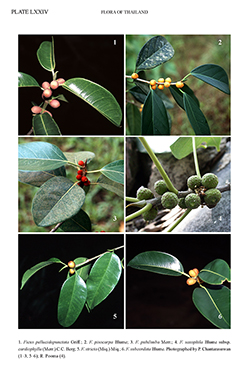e-Flora of Thailand
Volume 10 > Part 4 > Year 2011 > Page 640 > Moraceae > Ficus
URO35. Ficus stricta (Miq.) Miq.wfo-0000690431
Ann. Mus. Bot. Lugd. Bat. 3: 266, 288. 1867; King, Ann. Roy. Bot. Gard. (Calcutta) 1(1): 44, t. 53. 1887; Gagnep., Fl. Indo-Chine 5: 758. 1928; Kochummen, Tree F1. Malaya 3: 157. 1978; C.C.Berg & Corner, Fl. Males., Ser. 1, Spermat. 17(2): 679. 2005.— Urostigma strictum Miq., Pl. Jungh. 50. 1851; Miq. in Zoll., Syst. Verz. 2: 91. 1854. Plate LXXIV: 5.
Accepted Name : This is currently accepted.
Synonyms & Citations :
Description : Tree to 30 m tall, hemi-epiphytic (?) or (secondarily?) terrestrial. Branches drying brown to greyish to blackish, often distinctly lenticellate. Leafy twigs 2–3 mm thick, ± angular, glabrous (or minutely white puberulous); periderm often flaking off. Leaves subdistichous; lamina elliptic, oblong or (sub)ovate, 8–14 by 3.5–6 cm, coriaceous, apex shortly acuminate, base cuneate to rounded, margin flat, often callose towards the base; both surfaces glabrous; midrib slightly impressed, lateral veins 10–14(–16) pairs, the basal pair not or ± hardly distinct, to ⅒–⅙ the length of the lamina, unbranched, tertiary venation parallel to the lateral veins; waxy gland at the base of the midrib; petiole 0.9–1.8 cm long, ca 2 mm thick, glabrous, drying pale brown; stipules 1.5–3 cm long, glabrous, often drying pale brown (to blackish), caducous, often involute when dry. Figs axillary, paired (or solitary), sessile, initially enclosed in calyptrate bud covers to 0.7 cm long; basal bracts 3, 4–6 mm long, unequal in size and shape, glabrous, persistent; receptacle subglobose, (0.8-)1–1.8 cm diam. When dry, glabrous (or sparsely minutely puberulous), yellow to orange to dark red (or pink to purple) at maturity, apex convex to slightly concave, ostiole 1.5–2 mm diam., ± prominent, ± open, the upper ostiolar bracts usually not fully imbricate, glabrous; wall ± shrivelled when dry; internal hairs absent. Tepals (partly) red. Ovary partly red to whitish.
Thailand : NORTHERN: Chiang Mai, Lampang; CENTRAL: Nakhon Nayok; PENINSULAR: Nakhon Si Thammarat, Songkhla, Narathiwat.
Distribution : India (Andaman Islands), S China?, Vietnam, Peninsular Malaysia, Singapore, Indonesia (Sumatra, Java – type).
Ecology : Dry evergreen and evergreen forests, on sandstone, to ca 800 m alt.
Notes: This species differs from Ficus benjamina in the size of the bracts, mostly 5–8 mm long. When sterile, it can usually be distinguished by the longer stipules, mostly 1.5–2.5 cm long.
Bänzinger 1082 -L from Chiang Rai, S of Mae Sai, at 1,000 m, in rugged limestone terrain, is not included in the present description. It differs from other collections in the rounded to subcordate base and shortly and bluntly acuminate to rounded apex of the lamina, the small figs, 0.7–0.8 cm diam, when dry, the 3–4 mm long basal bracts, and the short, to 1 cm long, minutely white puberulous stipules.

